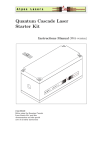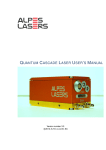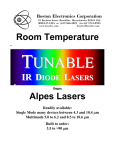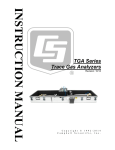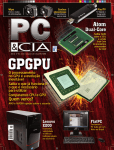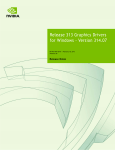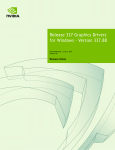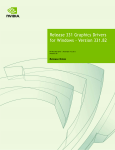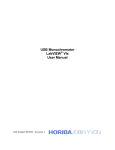Download Alpes Lasers Cascade Laser Starter Kit Datasheet
Transcript
QCL FAQ List Frequently Asked Questions about Quantum Cascade Lasers and Starter Kit from Alpes Lasers SA This FAQ should address the main questions arising for and from operation of CW and pulsed mode QC lasers from Alpes Lasers SA, especially in combination with the Starter Kit. The information given herein is based on best knowledge, but since lasers can behave differently, no guarantee can be given that it will hold true in any case. The first information source concerning the Starter Kit is the corresponding manual. Please read it thoroughly before seeking additional information about the Starter Kit. Contact Alpes Lasers in case of doubt or concerning limitations for a particular laser. c 2007, Alpes Lasers SA, Neuchˆ Copyright ° atel Contents 1 Mechanical and geometrical properties 1.1 Geometry of QC lasers . . . . . . . . . . . . . . . . . . . . . . . . 1.1.1 How are the axes of the laser defined, i.e. what is vertical? 1.1.2 What are the physical dimensions of laser carriers? . . . . 1.1.3 What materials are used for the laser carriers? . . . . . . . 1.2 How to handle a QCL . . . . . . . . . . . . . . . . . . . . . . . . . 1.2.1 How do I store a QCL? . . . . . . . . . . . . . . . . . . . . 1.2.2 How do I handle (carry) a QCL? . . . . . . . . . . . . . . . 1.2.3 How to mount a QCL in an optical setup . . . . . . . . . . . 1.2.4 Soldering wires to submount . . . . . . . . . . . . . . . . . . . . . . . . . . . . . . . . . . . . . . . . . . . . . . . . . . . . . . . . . . . . . . . . . . . . . . . . . . . . . . . . . . . . . . . . . . . . . . . . . . . . . . . . . . . . . . . . . . . . 3 3 3 4 4 5 5 5 5 5 2 Electrical and optical properties 2.1 Electrical limits . . . . . . . . . . . . . . . . . . . . . . . . . . . . . . . . 2.1.1 What is the maximum allowed duty cycle? . . . . . . . . . . . . . 2.1.2 What happens if I increase the duty cycle? . . . . . . . . . . . . 2.1.3 What is the lifetime of the laser (MTBF)? . . . . . . . . . . . . . . 2.2 Electrical properties . . . . . . . . . . . . . . . . . . . . . . . . . . . . . 2.2.1 What impedance does a QCL show? . . . . . . . . . . . . . . . . 2.2.2 Can I check the impedance with an ohm-meter? . . . . . . . . . 2.2.3 Where is the cathode of a QCL? . . . . . . . . . . . . . . . . . . 2.2.4 How do I drive a pulsed QCL? Can I use a standard laser driver? 2.2.5 How do I drive a CW QCL? . . . . . . . . . . . . . . . . . . . . . 2.3 Optical properties . . . . . . . . . . . . . . . . . . . . . . . . . . . . . . 2.3.1 Mode characteristics . . . . . . . . . . . . . . . . . . . . . . . . . 2.3.2 What is the polarisation of the emitted mode? . . . . . . . . . . . 2.3.3 How do I collimate the beam? . . . . . . . . . . . . . . . . . . . . 2.3.4 How do I calculate the radiance? . . . . . . . . . . . . . . . . . . . . . . . . . . . . . . . . . . . . . . . . . . . . . . . . . . . . . . . . . . . . . . . . . . . . . . . . . . . . . . . . . . . . . . . . . . . . . . . . . . . . . . . . . . . . . . . . . . . . . . . . . . . . . . . . . . . . . . . . . . . . . . . . . . . . . . . . . . . . . . . . . . . . . . . . 7 7 7 7 8 8 8 8 8 8 9 9 9 10 10 10 3 Starter Kit (pulser, temperature controller, etc...) 3.1 Operation of TE cooler . . . . . . . . . . . . . . . . . . . . . . . . . . . . . . . . . . . . . 3.1.1 What is the dissipated heat of a pulsed QC laser? . . . . . . . . . . . . . . . . . 3.1.2 What temperatures can be reached with the TCU-151? . . . . . . . . . . . . . . 3.2 Important points concerning LDD pulsers . . . . . . . . . . . . . . . . . . . . . . . . . . 3.2.1 What are the possible pulse lengths and duty cycles? . . . . . . . . . . . . . . . 3.2.2 What is the ”external power supply” used for? . . . . . . . . . . . . . . . . . . . 3.3 Low-impedance line . . . . . . . . . . . . . . . . . . . . . . . . . . . . . . . . . . . . . . 3.3.1 How to connect the low-impedance line . . . . . . . . . . . . . . . . . . . . . . . 3.4 Low-frequency bias current for modulation . . . . . . . . . . . . . . . . . . . . . . . . . 3.4.1 What are function and purpose of a bias-T circuit? . . . . . . . . . . . . . . . . . 3.4.2 What are the connections of the bias-T circuit? . . . . . . . . . . . . . . . . . . . 3.4.3 Dangers and disadvantages of using a bias-T circuit . . . . . . . . . . . . . . . . 3.4.4 What has to be kept in mind before use? . . . . . . . . . . . . . . . . . . . . . . 3.4.5 What are the current and voltage ranges of the bias-T circuit? . . . . . . . . . . 3.5 Laser Laboratory Housing (LLH) . . . . . . . . . . . . . . . . . . . . . . . . . . . . . . . 3.5.1 What is the distance of the laser die output facet from the window external facet? . . . . . . . . . . . . . . . . 11 11 11 11 11 11 12 12 12 12 12 13 13 13 14 14 14 1 . . . . . . . . . . . . . . . . . . CONTENTS 2 3.5.2 What is the reflectivity of the LLH window? . . . . . . . . . . . . . . . . . . . . . . 4 Operating QCLs in continuous wave mode 4.1 Thermal properties . . . . . . . . . . . . . 4.2 Modulation of a CW mode operated QCL . 4.2.1 Direct modulation of the DC source 4.2.2 Additional modulated supply . . . . 14 . . . . . . . . . . . . . . . . . . . . . . . . . . . . . . . . . . . . . . . . . . . . . . . . . . . . . . . . . . . . . . . . . . . . . . . . . . . . 15 15 15 15 15 5 General QCL questions 5.1 How to measure QC laser emission? . . . . . . . . . . . 5.2 General emission characteristics . . . . . . . . . . . . . . 5.2.1 What wavelengths can be reached? . . . . . . . . 5.2.2 Why is such a large range obtainable? . . . . . . 5.2.3 How ”CW” does a QCL look like in pulsed mode? 5.2.4 What optical powers can be expected? . . . . . . 5.2.5 How precise should emission be specified? . . . . 5.3 Tuning and linewidth . . . . . . . . . . . . . . . . . . . . . 5.3.1 How does a DFB-QCL tune? . . . . . . . . . . . . 5.3.2 How much can a DFB-QCL be tuned? . . . . . . . 5.3.3 Why is the line-width of a DFB-QCL limited? . . . 5.3.4 How and how much does a FP-QCL tune? . . . . . . . . . . . . . . . . . . . . . . . . . . . . . . . . . . . . . . . . . . . . . . . . . . . . . . . . . . . . . . . . . . . . . . . . . . . . . . . . . . . . . . . . . . . . . . . . . . . . . . . . . . . . . . . . . . . . . . . . . . . . . . . . . . . . . . . . . . . . . . . . . . . . . . . . . . . . . . . . . . . . . . . . . . . . . . . . . . . . . . . . . . . . . . . . . . . . . . . . . . . . . . . . . . . . . . . . . . . . 18 18 18 18 19 19 19 19 20 20 20 20 20 6 Glossary and Abbreviations . . . . . . . . . . . . . . . . . . . . . . . . . . . . 22 Chapter 1 Mechanical and geometrical properties QC lasers from Alpes Lasers SA are mounted on special carriers (NS or ST), which require special handling and definition of geometrical orientation. 1.1 Geometry of QC lasers 1.1.1 How are the axes of the laser defined, i.e. what is vertical? The vertical direction is the so called growth direction. In practice, you have a device in front of you, it is mounted on a copper carrier. The carrier has one or two ceramic pads carrying the bonding wires. The pads are yellow on top due to a layer of gold, and white around it and on the sides (colour of the ceramic). If these pads are placed upwards, the vertical for the laser is the same as the observer vertical direction. If there are two ceramic pads present, they are named as follows: Looking onto the front facet with the laser placed as described above, the pad left of the laser chip is called ”down”, the one right of it ”up”. If no configuration is specified, the ”down” pad is used. 3 CHAPTER 1. MECHANICAL AND GEOMETRICAL PROPERTIES 4 1.1.2 What are the physical dimensions of laser carriers? There are two versions, the ST and the NS; dimensions for both are given in the drawings. Never place the laser upside-down, since this will damage the bond wires connecting the pads to the laser! 1.1.3 What materials are used for the laser carriers? The carriers are composed of a OFHC gilded base, one or two ceramic gilded connecting pads and AIN gold plated bonding wires. ST Emission DN UP NS Emission UP DN Note: Dimensions are in mm CHAPTER 1. MECHANICAL AND GEOMETRICAL PROPERTIES 5 1.2 How to handle a QCL 1.2.1 How do I store a QCL? QCLs can be stored at ambient temperature (10..30C) in normal atmosphere. Humidity should not excess about 80%, and condensation is to be avoided. When operated, only dry atmosphere (below 50% relative humidity) is allowed, and if possible, it should be completely dried (desiccant material, N2 atmosphere). The laser should always lay flat (with its vertical axis upwards) on a flat and stable surfaces, without touching anything around its circumference. Of course, when mounted in an appropriate and stable holder, it can be operated in any orientation. 1.2.2 How do I handle (carry) a QCL? The most delicate parts of a QCL are the laser chip itself and the bonds connecting it to the ceramic pads. Therefore the QCL should be touched only at the copper carrier (far from the laser chip and the bonds), or at the ceramic pads (again away from the bonds). To insert it into or to take it out of the Starter Kit housing, gently grab the ceramic pad from above with fine tweezers, and whenever possible, carry the QCL placed flat on a stable surface. Take special care not to touch bonds nor the laser chip itself, since this can immediately destroy the QCL. Avoid contact of the front facet of the QCL with any object (like the walls of a box where it is stored). 1.2.3 How to mount a QCL in an optical setup Depending on the type of the laser operation temperature (room or liquid nitrogen), different mounting techniques exist. RT-QCL The laser can be installed in a housing (LLH part of the Starter Kit) and screwed (with NS) or simply friction tightened to its support (with ST) . LN2-QCL In this case, the laser is necessarily contained in a Dewar or other cryogenic system, and the manufacturer of this equipment should be contacted. Regarding the inside placement, Alpes Lasers SA can provide consulting service for the attachement of the QCL chip holder to the cold finger. 1.2.4 Soldering wires to submount If you want to solder wires to the laser submount, please contact Alpes Lasers SA first, otherwise warranty may be lost! Here, the basic procedure and needs will be explained. CHAPTER 1. MECHANICAL AND GEOMETRICAL PROPERTIES 6 As the QCL chip itself is soldered, and the contact pads on the ceramics are made of Gold, it is not possible to use normal Lead-Tin solder (temperature too high, and solder will destroy Gold contacts by forming alloy). Alpes Lasers SA recommends use of pure Indium for soldering, in the form of paste of microscopic beads in flux. It is of highest importance to never touch any part of the laser chip itself (especially not the facets) nor the bonds, as this may result in fatal damage to the QCL. Solder with a very fine tip solder iron at about 170C, only at the corner of the contact pad which is most distant from the bonds and the chip, and only very thin and flexible wires. Chapter 2 Electrical and optical properties This chapter discusses electrical properties of pulsed and CW QC lasers for special issues concerning CW operation, see Chapter 4, (CW mode), p.16. 2.1 Electrical limits 2.1.1 What is the maximum allowed duty cycle? This strongly depends on the laser. As a general rule, most lasers sold by Alpes Lasers SA are capable of being driven up to 10% duty cycle with pulse lengths up to 100ns. Whenever you drive a laser at a duty cycle higher than specified, monitor the average output power; do not increase the duty cycle any more when the power saturates, but reduce it again to stay on the safe side. If possible, increase the duty cycle by reducing the pulse period, not by increasing the pulse length, since the latter is more dangerous: It increases the short time heat load on the laser, instead of the average heat load. Before doing such experiments, it is recommended to contact Alpes Lasers SA, otherwise the responsibility is with you! 2.1.2 What happens if I increase the duty cycle? You will see no decrease of the maximum instantaneous power of the device up to 2..5% depending on the device. Around 5..20%, the maximum average power will be obtained. Over this limit, the increase of average power due to increase of duty cycle will be smaller than its decrease due to increased threshold current (caused by higher average temperature of the structure). The precise percentages depend both on the technology used (normal pulsed 2 mW or high power DFB) and the wavelength. For normal pulsed devices at short wavelength (4..5um), the maximum duty cycle is 3..5%, and at longer wavelength it may go up to 8% or even 20% for high power DFBs. 7 CHAPTER 2. ELECTRICAL AND OPTICAL PROPERTIES 8 2.1.3 What is the lifetime of the laser (MTBF)? At present only extrapolated lifetime experiments have been performed and they show more than 10 years extrapolated lifetime at 20C. The measurements have been done operating devices under N2 atmosphere at 130C in pulsed mode at 130% of threshold current. (An activation energy of 0.7 eV has been used to convert the high temperature life time of 350 to 500 hours to room temperature life time.) 2.2 Electrical properties For information about thermal properties, See section 3.1 (Heating and Cooling),p.12. 2.2.1 What impedance does a QCL show? The impedance of a QCL depends strongly on the wavelength it is designed for, the temperature and the mode it is operated, therefore only rough indications can be given here (consult the datasheet of a particular laser for exact behaviour). Pulsed mode devices have an impedance in the region of 5..50 Ω up to about half the threshold current, then it decreases to the region of 0.5..5 Ω. When operated at too high current, the impedance can rise again (a condition to be avoided in any case). 2.2.2 Can I check the impedance with an ohm-meter? Certainly (as long as the applied current is not higher than 10mA), but it might not give you a lot of information, since the impedance varies strongly with the temperature of the QCL, and normal ohm-meters do not specify the applied current. Therefore, the measured impedance varies also with the resistance range of the ohm-meter, and between different ohm-meters. This is also the reason why Alpes Lasers SA does not specify the DC resistance of QCLs. 2.2.3 Where is the cathode of a QCL? By default, the cathode is connected to the ceramic pads and the anode is connected to the copper carrier. It may happen that the laser is mounted junction down; this case is clearly indicated on the laser box, and then the cathode is connected to the carrier and the anode to the bonding pads. 2.2.4 How do I drive a pulsed QCL? Can I use a standard laser driver? Unfortunately, it is in general not possible to use a standard laser driver for a QCL, as in most cases the compliance voltage, current and rise/fall time are not compatible. Requirements for a pulsed QCL: • pulse current of up to 10A • voltage of up to 12V CHAPTER 2. ELECTRICAL AND OPTICAL PROPERTIES 9 • maximum rise/fall time of 10ns (to prevent detrimental heating) Alpes Lasers SA produces Starter Kits which provide at the same time driving, temperature control and protection of the laser chip. For a CW QCL, some standard laser drivers can provide the necessary conditions. 2.2.5 How do I drive a CW QCL? A CW QCL is about as sensitive to electrical surges and instabilities as a conventional bipolar laser diode (telecom NIR laser). It is necessary to use a good quality power supply to ensure: • current onset is formed by well controlled ramps without surges • current and voltage compliance can be precisely set (1mV/1mA) • current and voltage are stable within 0.1% We recommend precision laser diode current sources such as the ILX Lightwave LDX-3232. 2.3 Optical properties 2.3.1 Mode characteristics The emitted mode is single lateral, and also single longitudinal for the DFB devices. The divergence is 60deg FWHM in the vertical direction and 40deg FWHM in the horizontal direction. See the images on our website at (www.alpeslasers.ch/technology/Technology.htm). Why do we observe such a far field? The QCL is based on a mechanism (inter sub-band transitions) that exhibits a poor efficiency: most of the electrons emit phonons instead of photons. The laser thus heats a lot and thermal management at the microscopic scale of the waveguide is important to allow operation. The waveguide is thus very small in the vertical direction (i.e. perpendicular to the quantum wells plane) in order to optimize the overlap between the optical mode and the gain region. Why is the horizontal divergence not the same for all lasers? Depending on the wavelength and parameter optimised in a laser, it requires a different optimization of the width of the laser stripe. This results in a varying lateral confinement on the beam, thus various lasers at different wavelengths may exhibit pretty different lateral divergence. The lateral divergence is always smaller than the vertical divergence. CHAPTER 2. ELECTRICAL AND OPTICAL PROPERTIES 10 Is it possible to reduce the divergence? The divergence in the vertical direction is a parameter that is governed by the thickness of the laser waveguide. It is high because the waveguide is narrow. Reducing the divergence would impair the performances of the laser. Moreover this modification would need tremendous development effort and it would be necessary to compromise on the power and operation temperature. 2.3.2 What is the polarisation of the emitted mode? The polarisation is vertical if the laser is laying horizontally, i.e the electrical field is perpendicular to the plane formed by the ceramic pads, see (Axes of lasers). It is very pure as there is a quantum mechanical selection rule forbidding emission in the horizontal direction. 2.3.3 How do I collimate the beam? Due to the large divergence of the beam, it is recommended to use fast optics (f/1 . . . f/0.8) to collect most of the emitted light. We recommend the lens system from Cascade Technologies (see http://www.cascade-technologies.com), and aspheres from Janos (see http://www.janostech.com) or Optical solutions (see http://www.opticalsolutionsinc.com). 2.3.4 How do I calculate the radiance? The radiance can be estimated in two ways: • Supposing the laser is emitting monomode transversal and ideal optics for a gaussian 00-beam apply, the radiance is then given by B = 4 × P/(λ2 ), with P the optical output power and λ the wavelength of the laser. • Using standard values (which can vary for up to factors of 2 between lasers), the aperture A is in the range of 0.03mm by 0.005mm, and the illuminated solid angle (for 60deg vertical and 20deg horizontal divergence) W is in the range of 0.3 (or 2 × π × 0.045), and therefore the radiance B = P/A/W or approximately B = P/(4e − 5mm2 ). These are highly approximative values; if you need well defined ones, ask for the needed values for a specific laser you are interested in. Chapter 3 Starter Kit (pulser, temperature controller, etc...) This chapter discusses properties of the Starter Kit, used for pulsed mode lasers. 3.1 Operation of TE cooler 3.1.1 What is the dissipated heat of a pulsed QC laser? Pulsed QC lasers in general work at threshold voltages of 9V...12V and threshold currents of 1A...3A, with maximum values of up to 25V and 10A. The peak power during operation therefore can vary in the range of about 10W...1000W. Depending on duty cycle, the mean dissipated power normally is in the range of some Watts. 3.1.2 What temperatures can be reached with the TCU-151? Normally, the TCU-151 is shipped with current limitation of 5A and alarm value of 65C. Depending on the heat sink used, temperatures between -35 and +60C may be reached. Very high and low temperatures induce more stress on the Peltier elements and therefore accelerate ageing. 3.2 3.2.1 Important points concerning LDD pulsers What are the possible pulse lengths and duty cycles? The pulse driver LDD100 can amplify pulses with lengths of 5ns...300ns and minimal period of 100ns. Maximal duty cycle is 50% (with reduced stability and not continuously to prevent overheating, up to 90%). The pulse generator TPG128 is capable of generating pulses with lengths of 20ns...200ns (with reduced stability down to 10ns) and period of 0.2µs...10.5µs. Duty cycle can vary in the range of 0.1%...80% (with reduced stability up to 95%). In combination with LDD100, only 50% duty cycle can be reached, since the power supply in TPG128 which is feeding LDD100 is not specified for higher values. Provide external power source for LDD100 if more than 50% is needed. In any case, contact Alpes Lasers SA first, if duty cycles of more than 2% are needed. 11 CHAPTER 3. STARTER KIT (PULSER, TEMPERATURE CONTROLLER, ETC...) 3.2.2 12 What is the ”external power supply” used for? The ”external power supply” is a DC power supply provided by the user; it is connected (via banana plugs) to the pulse driver LDD100 and is delivering the electrical power feeding the laser. Any standard laboratory power supply can be used, as long as it is ripple-free (≤1%), voltage regulated, with variable voltage from 0V to at least 35V, and capable of delivering 1A DC for duty cycles up to 2%. For higher duty cycles, contact Alpes Lasers SA, since not all lasers are capable of working at more than 2%. 3.3 3.3.1 Low-impedance line How to connect the low-impedance line The low-impedance line LBI100 has a locating pin to avoid false connection on the LLH laser housing and on LDD100. The LBI100 has to be connected with ”NEG” up unless specifically told to connect with ”POS” up. Do not twist the LBI100. 3.4 Low-frequency bias current for modulation This section describes use of a bias-T circuit for electrically controlled modulation of peak emission wavelength. For modulation of a CW QCL, please refer to section 4.2 (CW modulation),p.16. 3.4.1 What are function and purpose of a bias-T circuit? What is the function of the bias-T? The bias-T allows to apply a constant (DC) current to the laser in addition to the pulsed current (therefore a bias-T is useless in CW mode). The current is drawn from the external (user supplied) power supply through the laser. This current can be controlled electrically. Alpes Lasers SA specifies use up to of 0.1kHz, but several clients have used the bias-T successfully at frequencies of up to several kHz. What is the purpose of using a bias-T? Since tuning of a QC laser is done by changing the temperature of the active zone, the DC bias current can be used to control the emission wavelength of the laser via its heating effect. The bias-T therefore allows for electrically controlled rapid scanning of the emission wavelength. Why is using a bias-T better than changing base temperature? Tuning can also be achieved by changing the temperature of the whole laser but at much lower speed, due to the high thermal capacity of the laser submount and laser base. Heating of the active zone alone by applying a DC bias current is affecting only the active zone and the surrounding parts of the laser chip, and due to the small CHAPTER 3. STARTER KIT (PULSER, TEMPERATURE CONTROLLER, ETC...) 13 thermal capacity of this tiny volume, the laser emission responds much faster to DC bias current variations. 3.4.2 What are the connections of the bias-T circuit? The bias-T circuit is either separately attached to the low-impedance line connecting the pulser and the laser housing, or directly included in the pulser. Connections are different in the two cases: External circuit connected to low-impedance line In this case, the bias-T box is soldered to the top contact of the low-impedance line with the red wire. The black wire (with banana plug) must be connected to the negative pole of the external user supply. The connector labelled IN receives the control voltage (0.6...2.6V, center positive), the connector labelled MONI allows monitoring of the bias current. Circuit included in pulser unit The circuit included in the LDD100 pulser unit is controlled by the twisted black and yellow wires of the control cable (with the DSUB-9 plug). They correspond to the shield and center of the IN connector in the former case (positive voltage on yellow wire). This version has no monitor connection. 3.4.3 Dangers and disadvantages of using a bias-T circuit • Since a bias-T only allows to heat the laser, the emission wavelength can only be increased (or emission wavenumber decreased), and output power will decrease with increased bias current, due to the additional heating. This means that the laser should be operated initially at lowest possible temperature, and it reduces the number of lasers available for reaching a given emission wavelength. • Heating of the active zone will increase thermal stress of the laser, therefore the expected lifetime will decrease more rapidly compared to increasing the temperature of the laser submount and base in total. If operation at only a fixed wavelength is needed, this should be adjusted with the overall temperature control. • Too high a DC bias current can immediately destroy the laser due to catastrophic thermal roll-over. Therefore set-up of the bias current has to be done only by instructed personnel, and after checking with Alpes Lasers SA for allowed parameter ranges; otherwise warranty will be lost. 3.4.4 What has to be kept in mind before use? • All use of a bias-T on a specific QC laser has to be accepted by Alpes Lasers SA before; otherwise all warranty will be lost. • The bias-T should never be used at the highest specified current or output power, otherwise the risk of thermal roll-over failure is imminent. • If optical output power can be monitored, this should be used during set-up of the bias-T to make sure that thermal roll-over is not reached: Temporary increasing of CHAPTER 3. STARTER KIT (PULSER, TEMPERATURE CONTROLLER, ETC...) 14 the pulse current must always result in increased optical power output, otherwise the DC bias current is already too high. • As a rule of thumb, the overall dissipated power (sum of DC bias current dissipation and pulse current dissipation) must never be higher than the average dissipated power given by the highest current / voltage / temperature combination specified in the datasheet. Take into account that the average dissipated power for a given pulse current I, pulse voltage U, and duty cycle d is given by d × I × U , whereas the dissipated power due to a bias current IB is given by IB × U . (U is the voltage on the laser, but it is safe for this calculation of bias current dissipation to use the voltage on the LDD pulser input.) 3.4.5 What are the current and voltage ranges of the bias-T circuit? Since the input stage of the bias-T is a bipolar transistor, applied voltage must be higher than about 0.6V to start bias current. The input stage has maximum voltage limit of 2.6V, but the laser itself may be destroyed at lower bias-T control voltage already, therefore the maximum rating has to be checked with the abovementioned rules and together with Alpes Lasers SA. The monitor output (if available) allows measurement of applied DC bias current: Its voltage divided by 10 Ω gives bias current. In general, bias current can be in the range of 0.1A, but this must be checked with Alpes Lasers SA before. Avoid reverse polarity on the input! 3.5 Laser Laboratory Housing (LLH) 3.5.1 What is the distance of the laser die output facet from the window external facet? This distance is approx. 4.5 mm. 3.5.2 What is the reflectivity of the LLH window? For complete data and information about the LLH window, please refer to the website of Janos (www.janostech.com) and see the characteristics of ZnSe3-12 IR coating. Chapter 4 Operating QCLs in continuous wave mode For electrical properties, see ”Chapter 2, p 8, Electrical properties”. 4.1 Thermal properties The dissipated heat of a QC laser operated in CW mode is in the range of some Watts (operating voltage in the 8V...12V range, current in the 0.5A...1.5A range). Keep in mind that in general, the impedance of a QCL is decreasing with temperature! 4.2 Modulation of a CW mode operated QCL To modulate a CW operated QCL (e.g, to sweep its emission), there are two possibilities. 4.2.1 Direct modulation of the DC source If your DC supply allows for this, you should directly use its control input to change the output current (in the specifications given by the datasheet of course). Please make sure that its bandwith is sufficiently high for your application. 4.2.2 Additional modulated supply If your DC supply cannot be modulated (or not fast enough), you will have to add an additional modulated source, e.g, a waveform (ramp) generator. Alpes Lasers SA does not supply such generators nor the needed interfacing, but in the following, a scheme for setting up the interfacing is explained which has proven to work. Please refer to the drawings shown. 15 CHAPTER 4. OPERATING QCLS IN CONTINUOUS WAVE MODE 16 Connectors for the LLH with a BNC plug are available for CW laser operation. This is always center positive, shield negative, and can directly be connected to a stabilized DC supply; make sure polarity is correct and limits as shown in the datasheet are set. To modulate the QCL, an AC signal needs to be added to the DC current. To prevent current modulation to go back to the DC source, an RLC circuit needs to be added. The values of RAC , L, C depend on the modulation frequency, the AC source and (to some extent) on the QCL. rule of thumb for L As the impedance XL = 2πf L of the inductivity should be much higher than the dynamic resistance XQ of the laser to block the AC component from the DC supply, applying XL > 100XQ leads to roughly L > 16XQ /f . In general, XQ is of the order of 1..2 Ω. For a modulation frequency of 10kHz, L should therefore be of the order of 3mH or larger. rules of thumb for R and C To prevent the AC source from dominating or reverse biasing the current through the QCL, UAC < UQ must always be given (in absolute values). Furthermore, as the AC voltage source together with RAC , C is forming a current source, to prevent variations of QCL dynamic resistance XQ to influence the AC current, RA C + XC >> XQ must be guaranteed. As the generator for UAC will have an impedance ZAC , impedance matching demands for RAC + XC + XQ = ZAC . Putting these constraints together leads to IAC < UQ /ZAC . For the capacitor C to let pass the AC current, 2πRAC C > 1/f must be true, and with XC = RAC /100 or smaller to make sure that the impedance of the AC current source CHAPTER 4. OPERATING QCLS IN CONTINUOUS WAVE MODE 17 does not vary too much with frequency, it follows that roughly C > 8/ZAC /f . For a 50 Ω generator at 10kHz, C should therefore be of the order of 16uF or larger. Please keep in mind that such high capacity components may have a remarkably high inductivity, so it may be useful to put a second capacitor of small value (some nF, Tantalum or similar non-polarized type) in parallel to the one calculated before. Construction To reduce cross-talk with other system components and to improve mechanical stability, this interface circuit should be installed into a small metal box with only the connectors accessible, as shown in the following figure. Chapter 5 General QCL questions This chapter discusses some general properties of QC lasers, mainly concerning optical behavour. For additional information, see ”Electro-optical”. 5.1 How to measure QC laser emission? At Alpes Lasers SA, the following methods are used for detection and qualification of QC laser emission: Power meter To measure power, semiconductor power meters are used, in particular the combination of power head 2A-SH with meter AN/2 from OPHIR(www.ophir.com). Spectrometer Standard measurements are done with TRIAX320 monochromators from Jobin Yvon (http://www.jobinyvon.com), special (high resolution and CW) measurements with Nicolet 800 and 860 FTIR (www.nicolet.com). Fast detectors For time-critical measurements, Alpes Lasers SA recommends detectors from VIGO SYSTEMS (www.vigo.com.pl). Monitoring For monitoring laser emission, simple pyroelectric detectors can be used, e.g LGTP101 by MemTek (memtek.lgcit.com). 5.2 5.2.1 General emission characteristics What wavelengths can be reached? QC devices have been shown to be capable of operating between 3.44 and 84um. Devices with wavelength ranging from 4.2 to 11 um are currently available. Nevertheless we encourage you to discuss your needs if they lay outside this range. 18 CHAPTER 5. GENERAL QCL QUESTIONS 5.2.2 19 Why is such a large range obtainable? This peculiar characteristic is due to the fact that in QC devices the emission wavelength is determined by the geometry of the semiconductor layers that compose the laser crystal.1 More precisely, the laser transition is the transition of an electron inside sub-bands from one upper quantum well level to a lower quantum well level. For more details we would encourage the reader to consult semiconductor physics text book. Using two different semiconductor materials (InGaAs and AlInAs), a series of potential wells and barriers for the electrons can be built. These wells and barriers are so thin that the electrons are allowed only a discrete set of energy levels. This situation is very similar to the orbitals of an electron around a nucleus in the case of an atom. In the case of the QC structure, the positions of the permitted energy levels are determined by the thicknesses of the wells and barriers. It is thus possible, using only one material system (InGaAs/AlInAs grown on InP), to define laser transitions with energies ranging over a wide span. The limits are set, on the short wavelength range, by the potential difference between the wells and barriers, and on the other side by intrinsic absorptions of the material. In conclusion, a QC laser is a laser made with some sort of a specific composit designed specifically for each wavelength but always composed of the very same materials. 5.2.3 How ”CW” does a QCL look like in pulsed mode? For a slow detection system, a pulsed laser will appear CW. In order to define slow, see ”Line-width limit”. A pulse will last between 10 and 100 ns and will be repeated at a rate corresponding to 0...3% for usual DFBs and up to 10...20% for high power DFBs. At 10 ns pulse length, the line-width will be close to minimal in pulsed operation, less than 0.1/cm, and at 100 ns it will be larger, depending on the device. 5.2.4 What optical powers can be expected? No standard output power ranges exist at this time, but Output power in the range of 1 or 2 mW can be expected for stock devices. 5.2.5 How precise should emission be specified? Normally, specification to 0.5/cm or 1nm should be sufficient. As the laser tunes over several linewidths, it is possible to temperature tune it to adjust its central wavelength. It becomes critical only if extreme power is required or if the laser has to operate CW at LN2 for the same reason. 1 In standard bipolar semiconductor lasers (e.g. 1.55µm telecom devices), the emission wavelength is closely related to an intrinsic characteristic of the semiconductor material used, namely the band gap energy. CHAPTER 5. GENERAL QCL QUESTIONS 5.3 5.3.1 20 Tuning and linewidth How does a DFB-QCL tune? In QCLs there are no effects such as carrier density dependent index of refraction, therefore no current tuning is observed. The only tuning mechanism is temperature tuning of the index of refraction of the waveguide that changes the apparent optical length of the wavelength selection grating. This of course will result in an observable current tuning: the higher the current gets, the higher becomes the average temperature of the active region of the QCL. But this apparent current tuning is based on temperature tuning only. 5.3.2 How much can a DFB-QCL be tuned? The operation range of the device is -30...+30C (dT=60K). The relative tuning is constant for all wavelengths and is about 6E-5/K for wavelength and -6E-5/K for wavenumber. This results in a tuning range of about 0.4% of peak emission wavelength or wavenumber. For a 1500/cm device, the total tuning is approximately given by −6E − 5/K × 60K × 1500/cm i.e -5.4/cm. Note: The relative tuning has a minus sign for wavenumbers and a positive sign for wavelength. This is exactly opposite to how a lead-salt device would tune, for those accustomed to this type of devices. 5.3.3 Why is the line-width of a DFB-QCL limited? Like in every pulsed lasers, short enough pulses will lead to Fourier limited line width. For intermediate pulse length, the limiting factor is the thermal tuning of the device. The device heats up during the pulse and its emission wavelength follows and sweeps. Optimum pulses of 5 to 15 ns will enable to get a minimal linewidth. Some customers such as the company Aerodyne published data on the linewidth reachable using our devices and electronics (Starter Kit). Please have a look at (http://www.alpeslasers.ch/Conference-Papers/Workshop-Freiburg01.pdf) which describes measured line width in pulsed operation. The standard measurement setup we use enables to verify that the laser is single mode i.e. has a linewidth not exceeding 0.3/cm. 5.3.4 How and how much does a FP-QCL tune? A FP-QCL tunes because of the shift in gain of the structure with temperature. This tuning is about twice as fast as the index tuning of DFB-QCLs, i.e about 1.3E-4/K (increasing temperature will result in increased wavelength). On a Peltier cooler like the one included in the Alpes Lasers SA Starter Kit, the obtainable temperature span is about 60K (-30...+30C). Therefore the central wavelength CHAPTER 5. GENERAL QCL QUESTIONS 21 can be shifted by about 1.3E-4/K*60K or approximately 0.8% from the lowest to the highest temperature. Chapter 6 Glossary and Abbreviations CW Continuous Wave; for lasers this means operation with DC current, generating uninterrupted emission. DFB Distributed Feed-Back; describing a laser with an etched grating close to its active zone, which acts as a filter, reducing overall gain for all but the wavelengths defined by the grating period. This technique allows to produce single-mode lasers also for pulsed mode operation. FP Fabry-P´ erot; describing a laser whose emission spectrum is only defined by the gain of the active zone and the cavity of the cleaved laser chip, in contrast to a DFB laser. FTIR Fourier-Transform InfraRed; describing a type of spectrometer LN2 Liquid Nitrogen. Used also to describe temperature ranges reachable in LN2cooled systems with Dewars (approximatively 80... 130K). MTBF Mean Time Between Failure. See Lifetime section 2.1.3, p.9). QCL Quantum Cascade Laser. RT Room Temperature. In a more general way meaning temperatures in the range of -30...+50C, in contrast to cryogenic temperatures. TE Thermo-Electrical: TE coolers use Peltier elements as semiconductor heat pump. 22























